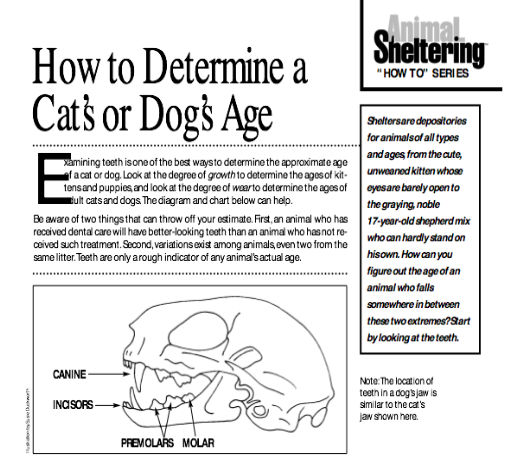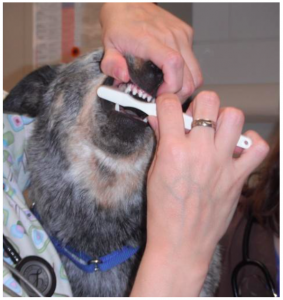8 Dentistry
Learning Objectives
- Describe normal tooth eruption in dogs and cats
- Describe appropriate home dental care for dogs and cats
- Describe the procedures that comprise a dental prophylaxis/COHAT (Comprehensive Oral Health Assessment and Treatment) in dogs and cats
- Explain the difference between the teeth of dogs and cats, and horses
- Describe routine dental care (floating) in horses including procedures and equipment used
*
Preventive dentistry routinely is practiced in dogs, cats, and horses. Some preventive dentistry may be provided for small exotic pets; that information is included in those specific modules later in the course.
*
 Small Animal Preventive Dentistry
Small Animal Preventive Dentistry
Puppies and kittens are born with no visible teeth. The deciduous (baby) teeth erupt over about the first 6 weeks of life and then are replaced by the permanent teeth by about 4-6 months of age. The incisors are lost first, then the premolars and finally, the canine teeth. The canine teeth are reliably lost at about 6 months of age and this

knowledge can be used to judge age of puppies or kittens. Most teeth are lost when the animal is eating and so are swallowed. This does not harm the puppy or kitten. Some dogs will grow in their adult teeth next to their deciduous teeth, without the deciduous teeth falling out. Those deciduous teeth should be removed as soon as possible as they may cause or worsen an abnormal bite and predispose the animal to dental disease.
One year, students found a chart on DVM 360 that stated that the sequence of eruption of adult teeth in small animals was incisors followed by canines followed by premolars. I checked with a veterinary dentist for clarification. When talking about animals losing their baby teeth, you have to differentiate eruption from complete replacement. Incisors always are first. Premolars and canines may erupt through the gum near the same time but because canines take longer to completely erupt, they are the last to be completely replaced in the mouth. So the sequence to remember for small animals is incisors – premolars – canines.
Determining Age of Cats and Dogs Through Their Teeth

| ESTIMATED AGE | CAT’S TEETH | DOG’S TEETH |
| 2-4 weeks | Deciduous (baby) incisors coming in | No noticeable tooth growth |
| 3-4 weeks | Deciduous (baby) canines coming in | Deciduous (baby) canines coming in |
| 4-6 weeks | Deciduous (baby) premolars coming in on lower jaw | Deciduous (baby) incisors and premolars coming in |
| 8 weeks | All deciduous (baby) teeth are in | All deciduous (baby) teeth are in |
| 3 1⁄2 – 4 months | Permanent incisors coming in | No noticeable permanent tooth growth |
| 4-5 months | Permanent canines,premolars, and molars | Permanent incisors coming in; some growth coming in of premolars and molars |
| 5-7 months | All permanent teeth in by 6 months | Permanent canines, premolars, and molars coming in; all teeth in by 7 months |
| 1 year | Teeth white and clean | Teeth white and clean |
| 1-2 years | Teeth may appear dull with some tartar build-up | Teeth may appear dull with some tartar (yellowing) on back teeth |
| 3-5 years | Teeth show more tartar build-up (on all teeth) | Teeth show more tartar build-up (on all teeth) and some tooth wear |
| 5-10 years | Teeth show increased wear and disease; pigment | Teeth show increased wear and disease visible on gums |
| 10-15 years | Teeth are worn and show heavy tartar build-up | Teeth are worn and show heavy tartar; some teeth may be missing |

Periodontal disease includes both gingivitis and periodontitis. Periodontal disease in small animals is caused by plaque and formation of pockets. On clean teeth, a biofilm develops in minutes and plaque in hours, with that plaque maturing over weeks and eventually mineralizing into calculus (tartar). Plaque is composed primarily of bacteria, and also contains water, saliva, minerals, and food particles. As the host’s immune system responds to formation of plaque, inflammation and disease develop under the gum line. This is gingivitis, inflammation of gingival tissue resulting from build-up of plaque and calculus and secondary accumulation of bacterial by-products and endotoxins. Gingivitis is reversible. If the process is not stopped, inflammation affects the periodontium and the supporting structures of the teeth. This is periodontitis and it is irreversible.
Periodontal Disease in Small Animals
| STAGE OF DISEASE | CLINICAL SIGNS | PATIENT/CLIENT RECOMMENDATIONS |
| Healthy | No evidence of disease, gums are coral pink, gingival margins are razor sharp | Brush teeth daily, provide dental toys and chews, present the animal for an oral examination every 6-12 months, plan for the first professional dental cleaning at 1 year of age (small dogs, cats) or 2 years of age (larger dogs) |
| Stage 1 | Inflammation of gingival margins, halitosis, gum edema, some bleeding upon probing of gums | Professional dental cleaning (consider full mouth dental radiographs), continue to brush teeth daily and provide dental toys and chews |
| Stage 2 | Moderate gingivitis, probing may show loss of attachment at tooth of up to 25% and pockets 3-5 mm in depth with more bleeding with probing, halitosis, teeth are stable | Professional dental cleaning (full mouth dental radiographs), continue to brush teeth daily and provide dental toys and chews |
| Stages 3 and 4 | Severe inflammation, bleeding gums and exposed tooth roots with tooth instability, severe halitosis | This is a level of disease requiring extensive dental treatment. The goal of preventive dentistry is to keep this level of disease from developing. |
*
Brushing Dogs’ or Cats’ Teeth: For Pet Owners
Here is an excerpt from a text for pet owners regarding how to brush their dog’s or cat’s teeth: To slow the development of dental disease, you can brush your pet’s teeth. If possible, you should accustom them to this practice when they are young, however pets of any age can be trained to accept brushing of teeth. Plaque usually accumulates on the surface of the teeth against the cheek. Only toothpaste specific for dogs and cats should be used. A soft, nylon-bristle toothbrush designed for dogs and cats, or a pediatric human toothbrush can be used. Brush once daily and do not worry about rinsing. Your animal will require a professional cleaning and polishing under general anesthesia periodically over its life. Your veterinarian will examine your animal’s teeth every time they do a physical examination and can give you advice regarding dental care.

Many products are marketed as means of maintaining good oral health in dogs and cats. These include foods, chews, oral rinses, and products to be dissolved in the drinking water. Some products have been proven to show some benefit, as described by the Veterinary Oral Health Council.
What procedures constitute a professional dental cleaning? Controversy exists regarding use of anesthesia for dental cleanings in dogs with minimal dental disease. The American Animal Hospital Association recommends that all dogs and cats undergoing a dental cleaning be maintained on an inhalant anesthetic with a properly cuffed endotracheal tube in place. A complete oral examination usually is best done with the dog or cat under general anesthesia.
Dental prophylaxis (commonly called a “prophy”) is performed on animals with a healthy mouth or very mild to moderate gingivitis. A thorough oral examination is performed. The teeth, including subgingival areas, are scaled with an ultrasonic scaler and curettes, and are then polished. This is the goal of preventive small animal dentistry. The 2019 AAHA Dental Care Guidelines outlines current recommendations for high-quality small animal dentistry in practice.
Conversation Points to Help Pet Owners Understand Preventive Dentistry
- Periodontal disease and infection are common; 91% of dogs and 85% of cats have some degree of dental disease. Dental disease can be painful and may cause the animal to change eating and drinking behaviors or other behaviors in ways that affect their overall health and how they interact with other animals and family members.
- Periodontal disease is preventable. Just looking at your own pet’s teeth is not enough, because gum disease starts beneath the gum line.
- Preventive dental care can slow or stop the progression of periodontal disease.
*

 Equine Dentistry
Equine Dentistry
Basics of Equine Dentistry [Click on this link for information about equine dentistry]
- Horses have deciduous (baby) teeth that are lost as the permanent teeth begin to erupt. There is a chart in the Extra Resources folder demonstrating timing of loss of deciduous teeth in the horse if you’re interested. Once permanent teeth begin to erupt, they continue to erupt over the horse’s life. There is a link to information in the Merck Manual about how to use examination of teeth to estimate age in horses.
- General anesthesia is induction of complete unconsciousness through the use of drugs. Horses (or any animal) under general anesthesia cannot stand. Specifically with horses, there are concerns about getting the horse down as you induce anesthesia and getting the horse up as it awakes from anesthesia. As you might imagine, as the horse loses and gains consciousness, it has abnormal balance and to have something that big lurching around is a danger to the animal and to the humans working with it. Outside of injury, horses also undergo a decrease in gut motility while under general anesthesia, which may be associated with colic after the anesthetic episode is done. For these reasons, we try not to induce general anesthesia and instead more commonly try to do standing sedation in horses, where they are given drugs that decrease anxiety and pain but do not induce complete unconsciousness. Some drugs control pain (analgesics) and some control consciousness (sedatives and general anesthetics). Some, but not all drugs do both.
- Floating is the term used to describe the removal of sharp points and small abnormalities of bite to make the horse more comfortable. The float is a rasp and as such, smooths and levels as it is used. Horses, as herbivores, need the occlusal surfaces of their teeth to be rough. You would never purposefully float the occlusal surfaces of teeth on a horse. Equipment and processes are well described at the link above (Basics of equine dentistry). It is routine in practice to flush the horse’s mouth with dilute chlorhexidine in water before and after dental floating and to clean instruments with chlorhexidine between horses.

*
 Extra Resources
Extra Resources
- 2020 WSAVA Dental guidelines: https://wsava.org/global-guidelines/dental-guidelines/
- Estimation of age by examination of the teeth in horses, cattle, and dogs: https://www.msdvetmanual.com/digestive-system/dental-development/estimation-of-age-by-examination-of-the-teeth
- Products that benefit oral health in dogs and cats: www.vohc.org
- Procedures for a professional dental cleaning: https://www.aaha.org/resources/your-pets-dental-care/
- Current recommendations for small animal dentistry in practice: https://www.aaha.org/wp-content/uploads/globalassets/02-guidelines/dental/aaha_dental_guidelines.pdf
- Basics of equine dentistry: https://pressbooks.umn.edu/app/uploads/sites/7/2019/08/8_Equine-Dentistry_Dr.-Linn.pdf
- Normal equine dentition: https://sceniccityvet.com/veterinary-services/dental-care

